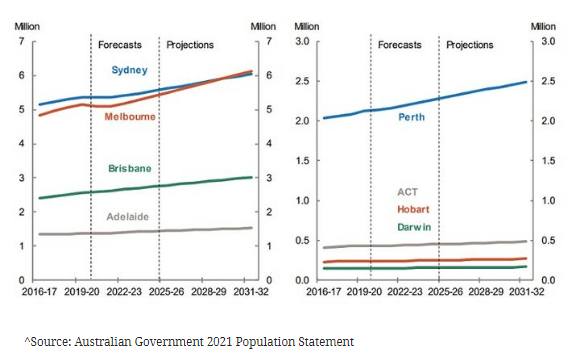In This Article
According to the federal government, Melbourne will become the nation’s fastest-growing metropolis next year and will overtake Sydney to become Australia’s largest capital by 2030.
According to the latest predictions from the Centre for Population, population growth would take a while to pick up, with only 0.3 percent growth expected in 2022, impeded by net overseas migration of 41,000 people.
This was up from a net outflow of 100,000 the previous year, the first time Australia’s population net overseas migration had fallen since World War II.
As overseas migration returns, federal housing minister Michael Sukkar predicts that capital cities would develop faster than the rest of their states starting in 2022-2023.
“While the picture remains uncertain due to Covid’s unpredictability,” Sukkar added, “when overseas migration resumes, population growth is predicted to increase to roughly 1.4 percent by 2024-2025.”
“From 2023-2024, Melbourne is expected to be the fastest-growing capital city, overtaking Sydney to become the nation’s largest metropolis in 2029-2030, with a population of just over 5.9 million.”
Australia’s population projections

This is in contrast to internal migration during the epidemic, when Queensland received the lion’s share of new inhabitants, followed by South Australia, with individuals fleeing lockdowns in Melbourne and Sydney.
By 2031-2032, Australia’s population is predicted to increase from 25.7 million in 2020-2021 to 29.3 million. This represents a reduction of 1.5 million people, or 4.9 percent, from pre-pandemic estimates.
Population growth is expected to accelerate from 0.3 percent to 1.4 percent in 2024-2025, before decreasing to 1.2 percent in ten years due to lower fertility and foreign migration.
While population growth was virtually non-existent from 2020 to 2021, it had no effect on the property market, which hit record highs.
Home values have risen by 22.1 percent in the last year, with the largest number of approvals for apartments and residences in November in Victoria.
According to the latest figures from the Australian Bureau of Statistics’ director of building statistics, Daniel Rossi, apartment approvals jumped 9.7% countrywide, while house approvals remained unchanged at 1.4 percent.
“Over the last year, the series has been at historically high levels, mostly fueled by government stimulus and record low borrowing rates,” Rossi added.
“While private home approvals are no longer at record highs, the November result is still 25.8% higher than the pre-pandemic level in November 2019, confirming the detached housing market’s continued strength.”
The housing bubble, however, is projected to come to an end in the coming years, owing to affordability issues as well as potential inflation and interest rate adjustments.




